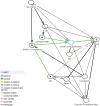Dialysis parameters associated with SARS-CoV-2 infection and prognosis in end-stage kidney disease
- PMID: 38738416
- PMCID: PMC11095274
- DOI: 10.1080/07853890.2024.2343890
Dialysis parameters associated with SARS-CoV-2 infection and prognosis in end-stage kidney disease
Abstract
Background: The Covid-19 pandemic has affected patients with end-stage kidney disease (ESKD). Whether dialysis parameters have a prognostic value in ESKD patients with Covid-19 remains unclear.
Materials and methods: We retrospectively evaluated clinical characteristics, blood pressure (BP) and dialysis parameters in ESKD patients undergoing maintenance outpatient hemodialysis, with (Covid-ESKD) and without (No-Covid-ESKD) Covid-19, at four Brazilian hemodialysis facilities. The Covid-ESKD (n = 107; 54% females; 60.8 ± 17.7 years) and No-Covid-ESKD (n = 107; 62% females; 58.4 ± 14.6 years) groups were matched by calendar time. The average BP and dialysis parameters were calculated during the pre-infection, acute infection, and post-infection periods. The main outcomes were Covid-19 hospitalization and all-cause mortality.
Results: Covid-ESKD patients had greater intradialytic and postdialysis systolic BP and lower predialysis weight, postdialysis weight, ultrafiltration rate, and interdialytic weight gain during acute-illness compared to 1-week-before-illness, while these changes were not observed in No-Covid-ESKD patients. After 286 days of follow-up (range, 276-591), there were 18 Covid-19-related hospitalizations and 28 deaths among Covid-ESKD patients. Multivariable logistic regression analysis showed that increases in predialysis systolic BP from 1-week-before-illness to acute-illness (OR, 95%CI = 1.06, 1.02-1.10; p = .004) and Covid-19 vaccination (OR, 95%CI = 0.16, 0.04-0.69; p = .014) were associated with hospitalization in Covid-ESKD patients. Multivariable Cox-regression analysis showed that Covid-19-related hospitalization (HR, 95%CI = 5.17, 2.07-12.96; p < .001) and age (HR, 95%CI = 1.05, 1.01-1.08; p = .008) were independent predictors of all-cause mortality in Covid-ESKD patients.
Conclusion: Acute Covid-19 illness is associated with variations in dialysis parameters of volume status in patients with ESKD. Furthermore, increases in predialysis BP during acute Covid-19 illness are associated with an adverse prognosis in Covid-ESKD patients.
Keywords: Covid-19; blood pressure; chronic kidney failure; hemodialysis; mortality.
Plain language summary
Dialysis parameters were influenced by SARS-CoV-2 infection and may have prognostic value in patients with Covid-19.Increases in blood pressure during acute Covid-19 illness and the lack of vaccination for Covid-19 were predictors of hospitalization for Covid-19.Hospitalization for Covid-19 and age were independent risk factors for all-cause death.
Conflict of interest statement
No potential conflict of interest was reported by the author(s).
Figures



References
Publication types
MeSH terms
LinkOut - more resources
Full Text Sources
Other Literature Sources
Medical
Miscellaneous
